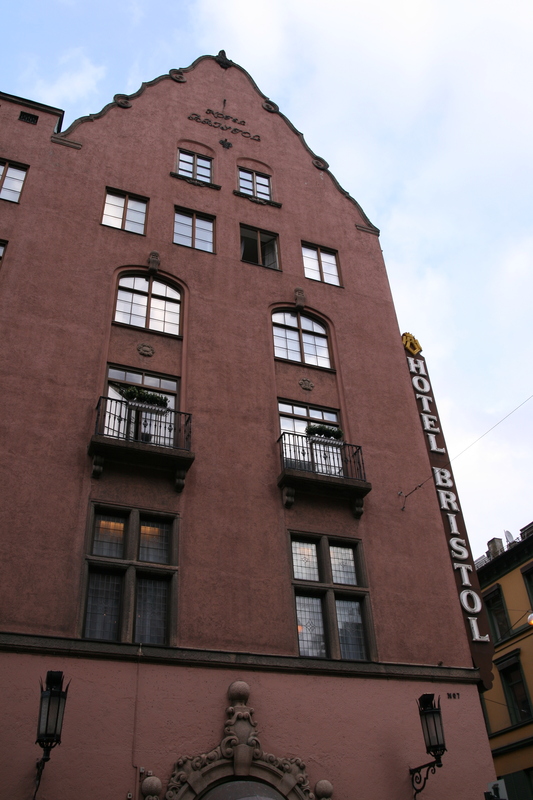10 tips on presenting a case study
One night I couldn't sleep I wrote a whole blog entry in my mind on how to do a good case study presentation on paper. I quite liked it, and so wrote it down on paper, and that paper has been lying around for a year or two now. Since the Topic Maps 2008 conference is coming up I figured this was a good time to finally post it, as the speakers are likely to be struggling with such presentations just now over the Easter break.
The motivation for this post is that usually when I attend a case study talk I go away with my head full of questions that didn't get answered in the presentation. What's strange is that very often they are the same questions. So figured that this time around I would ask them before the conference. I hope those of you writing presentations will see this, and find it useful. If nothing else it should give you 10 of the slides for your presentation.

Making an impact at Hotel Bristol |
1. Who are you?
Always start with who you are and where you work, plus your relationship with the project. Everyone in the audience will want to know this. What they do not want, however, is 10 minutes of you droning on about your employer. Your organization probably has lots of ready-made slides about itself, which is an easy source of material. Be very careful about using too much of it, however. 2 slides should be the max.
Another pitfall is to speak too much internal dialect, so that outsiders cannot actually understand what you are saying. You may want to test these slides on someone who is not a colleague to check if it is understandable.
2. What is the application?
This is crucial. You need to be really clear on what your application actually does, and what business needs it serves. You can see this as the answers to a list of questions: Why was the application built? Who uses it? For what? Where in this system did you use Topic Maps? Why?
Note that I'm not asking about the project. Information about that is useful, too, but secondary.
3. Conceptual architecture
This is equally crucial, and usually omitted. What is the structure of the application/system that you've built? What are the major components, and how are they related? The only way to show this, is with a boxes-and-arrows diagram that gives a rough outline. It doesn't need to be terribly detailed, as long as it covers things like application server, database, CMS, search engine, etc. Covering the data flow may also be a good idea.
Some presenters skip this altogether, and don't get into architecture at any level of detail at all. When they do I always feel like I don't really know what they've done, unless I've been able to piece together this information indirectly. So for me personally this is often one of the most important parts of the presentation.
Make sure to include actual product names! Omitting the product names tends to annoy me no end. Knowing what products others have used is always useful, and giving this information is nearly effortless for the presenter, so why anyone would leave it out I really can't understand. Presenters who omit this part can usually count on getting questions about this after their presentations, from me or from someone else. (Post-lunch speakers risk being pelted with fruit from the buffet. :-)
4. Show your ontology!

Ceiling lamp, Hotel Bristol |
A diagram showing the main classes and relations in the ontology is another thing the audience wants to see, and which makes a major difference in showing people what is actually going on. Don't worry about using UML/GTM or being very formal. That's not the point. The point is to at least give a rough outline of what is happening in the system. So an informal boxes-and-arrows diagram is good enough for this, too. (Plain text, on the other hand, is not the solution.)
One thing people probably worry about here, and that tends to cause them to leave this out, is a concern that their ontology is not complicated or fancy enough. That shouldn't really be a worry. A complex ontology is not necessarily good. Since end-users and authors need to understand the ontology it often can't be very complex, and in most systems it actually isn't that complex.
5. Screenshots are good!
For showing people what your application does there is nothing like screenshots. In this case, as in the two previous ones, a picture really does something a thousand words never could hope to achieve. A common problem here is to include the entire screen, so that the text in the screenshot becomes too small for people to read. If you do that you might as well leave the screenshots out, as this makes them useless. Instead, it's better to break them up into smaller pieces and show one piece at a time.
Don't overdo this, though. 2-3 screenshots is usually enough, and more than that tends to become too much quite quickly.
6. Numbers are good!
Generally, case studies tend to be very low on precise information, which makes them a lot less useful than they could be. So exact figures are good, even if getting hold of them tends to be difficult and require early planning (because you have to ask other people who often take a week to reply).
Good numbers are things like: How many authors? How many users? How many concurrent users? How many topics, associations, occurrences? How many topics of each type? How big was the project team? Budget numbers are good, too.
7. What's special about your application?
Most applications tend to have a lot in common, which is fine, but you should try to put the emphasis in your presentation on what makes your application different from the others. There is always something that is different about each application, and the difference tends to be the most interesting aspect for the audience. So try to find out how your project is different, and then emphasize that.
8. What was good?

Hotel Bristol |
What went well during your project? What were you happy with and felt worked for you? What are you pleased about in retrospect? What didn't cause problems? This type of information tends to be very valuable (and interesting) for others.
9. What was bad?
There is always something bad in every project, from illness through budget cuts to technical issues, and knowing about this always interesting for others. For those thinking about running their own projects it's always enlightening to hear that the biggest issues may be completely different from the ones they are worrying about.
Of course, in many cases the biggest problem is a people problem, in which case this part may require some tact, but it's still worth including. And don't worry about people's reaction when you tell them you had difficulties, since most people are experienced enough to know that all projects have their problems. So by including this you are more likely to impress people with your honesty and your ability to analyze your difficulties.
10. What's the status?
Very often, the presenter neglects to say whether or not the system described has been in production for a decade already, or whether they are still trying to find a customer for it. This is another omission that's sure to make people ask you questions at the end, since people always want to know what the status of your project is.
Talking a little bit about future plans is also a good way to wind up the presentation. Are you planning to scrap the system? Are you going to extend it? Let people know!
Similar posts
TMRA'05 — second day
(Second day of semi-live coverage from the TMRA'05 Topic Maps research workshop.)
Today we again start with Jack Park, this time speaking on "Just for Me: Topic Maps and Ontologies"
Read | 2005-10-07 13:33
TMRA 2007 — day 1
As usual, the conference was opened by Lutz, who gave a short introduction based around the conference motto of "Scaling Topic Maps"
Read | 2007-10-11 18:13
Emnekart 2006
This was the fourth Norwegian Topic Maps conference (emnekart is Norwegian for Topic Maps), and for the first time it was not entirely in Norwegian, as this year there was an English track through the whole conference
Read | 2006-03-30 20:59
Comments
Conal - 2008-03-16 17:26:06
Thanks very much for this Lars - I'm starting on my presentation today :-)
Marit Mellingen - 2008-04-02 09:23:07
Very useful. Already added a few slides to my presentation :-)
Peter - 2008-04-22 05:59:03
Thanks for the good overview. It really helped me to write the presentation for my conference contribution I will give next month.
Dushyant Kumar - 2012-04-19 14:25:55
It was great, for understanding the hierarchy of presentations. helps me lot, in my institute presentation.. thank you very much for sharing your way , so that one can think that in which direction one can think.....
aaronpaul lagrimas - 2012-09-11 21:37:31
it really help me a lot!!!! keep it up! now, i can start my case study presentation
mahrukh - 2012-12-30 03:50:16
mind blowing ..u`v done great job n awl over dat deze r very benificial for a student
Vilhelm Erichsen - 2013-04-12 21:29:57
I couldn't sleep either and need to present a chalanging budget. Gathered your post and now I feel better about the presentation. Thanks!
Srini Bojja - 2013-06-24 21:40:34
Thanks a lot for your inputs...helped me a lot!
kenneth mwelwa - 2016-02-09 09:08:32
thanks alot this post has really helped me on my collage assignment